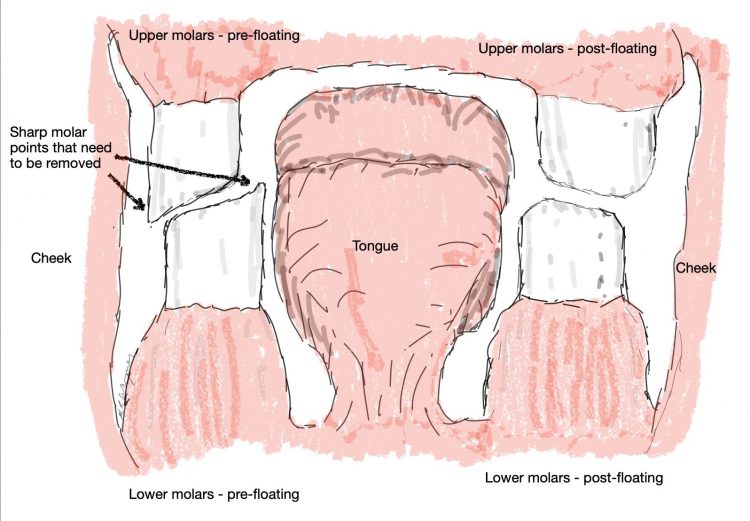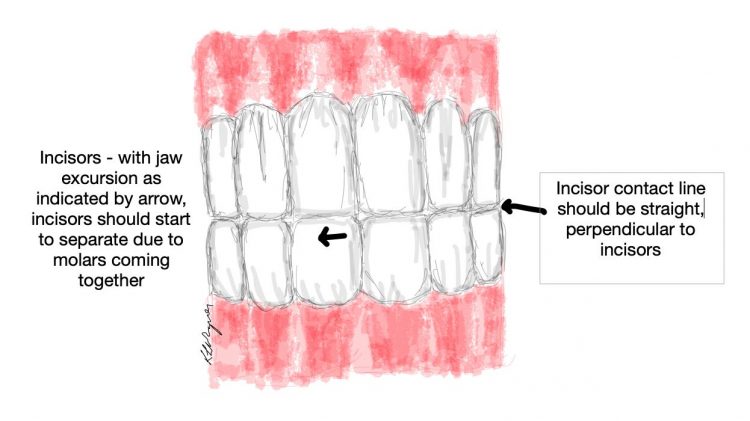It is a common misconception among horse owners, “if the horse is eating fine and not losing weight, their teeth are fine”. The truth of the situation is if you wait till the horse is having a chewing problem to float their teeth, you have waited 6 – 10 years to long. Routine dental care and floating is essential for the horse’s performance, well-being and care. Neglect of the teeth can produce pain and discomfort in the horse’s mouth resulting in head shyness and tossing, biting issues, riding behavioral problems and even lameness. These issues generally arise before you see a chewing or weight issue in your horse.
The act of removing sharp points from the horse’s teeth is called “Floating”. The file like instrument to remove the sharp points is called a float. The term originated from the carpentry/masonry trade of floating or leveling concrete. Although technically we do not want to level the teeth the term “floating” is used for equine dental care. More realistic is the “equilibration” of the horse’s teeth. We are bring the teeth back to a balanced functional arcade by eliminating or treating the pathological changes that have developed with time.
Let’s start with the normal anatomy of the horse’s mouth, how the teeth erupt and wear to demonstrate the need for floating. A mature horse has as many as 42 teeth in their mouth. Since the eruption of the horse’s teeth are relatively age related. The age of the horse can be estimated by examining the teeth. Although as the horse ages the accuracy of using the teeth to age a horse diminishes. In the process of aging teeth, we use the incisors or front teeth. Initially the deciduous or commonly called baby teeth arise with the central incisor up to day 7 of age, the second incisor at 4.5 – 6 months and the third or corner incisor at 6 – 9 months of age.
More consistence in age determination occurs with the next set of parameters. The permanent central incisor erupts form the gum at 2.5 years and is in maloclusive wear at 3 years of age. The permanent second incisor erupts at 3.5 years and is in wear at 4 years of age. While the third or corner incisor erupts at 4.5 years and in wear at 5 years of age. This time period in the horse’s life is most accurate on teeth age determination. At 10 years of age a groove called Galvayne’s groove on the lateral side of the third or corner incisor appears at the gum line. The groove travels to the occlusive surface as the tooth grows usually by 20 years of age. Galvayne’s groove is gone by 30 years of age.
In regards to the molars, there are 3 or 4 premolars and 3 molars, upper and lower on each side of the mouth. The variability of the premolars is the first premolar. It is the wolf tooth. The wolf tooth is a small tooth compared to the other molars. Not all horses have wolf teeth. Generally the wolf tooth is pulled before a bit is put in the horse’s mouth. Since the wolf tooth is small the bit contacting it will create discomfort or pain for the horse resulting in a head tossing behavior. The premolars and molars erupt at varying intervals from 6 months to 4 years of age. As the permanent molars erupt under the deciduous teeth, a cap is formed on the erupting permanent molar. This cap can become a “retained cap” which will need to be removed. Also these caps have very sharp points, so the cap can create a lot of pain by jabbing into the gum.

Along with the change of all the erupting teeth, the position and action during chewing of the mandible (jaw) on the maxilla (skull) creates sharp points on the outside (cheek) and inside (tongue) side of the molars (see drawing). The jaw teeth set narrower than the skull teeth. The occlusive surface which is the grinding surface of the teeth is set at about a fifteen degree angle with ridges in it. The angle allows for more grinding surface as the horse chews in a circular fashion. The angle of the molars and the ridges provide for a means of grinding the fibrous material of the horse’s diet. But the grinding action along with the continued eruption of the molars create the sharp molar points. These sharp molar points will lacerate the cheek or the tongue precipitating the need to float the horse’s teeth.

In regards to the floating procedure performed by your veterinarian or certified equine dentist, the exam is an important part of the procedure. All aspects of the mouth should be examined, gum, tongue, hard palate, salivary gland papilla, incisors, canines, molars. Besides evaluating the occlusive surface of the incisors and molars, each tooth and corresponding gum line should be evaluated for pathological changes and a plan formulated to correct the pathological issues. If the integrity and gum line of each tooth is normal, sharp points and excessive ridges should be removed from the molars along with small bevel put in the second premolar for a bit seat. Care is taken to maintain the fifteen degree angle and most of the occlusive surface ridges. After correcting the molars, the incisor occlusive surface should be evaluated. The contact line created by the incisors coming in contact should be a level line perpendicular to the incisors. With a ½ – 1 tooth worth of excursion, the incisors should start to separate due to the molar occlusive surface engagement (see photo). The slow growing canine teeth which are generally present in males are located behind the incisors in the interdental space. These teeth serve the purpose of defense during fighting in feral horses. In domestic horses the canine is an impedance with biting. Consequently they are generally lowered with a dremmel.
Since the molars continue to erupt until about 20 years of age and the chewing fashion, it is recommended to examine your horse’s teeth at least annually. Depending on your horse’s age and the proficiency of the person floating the teeth, floating should be performed every 6 – 18 months. If there is severe dental disease, a 3 month interval of exam and treatment may be required until balance is obtained. Although after 20 years of age if the teeth have been maintained efficiently through the life of the horse the floating interval may increase to 2- 3 years.
